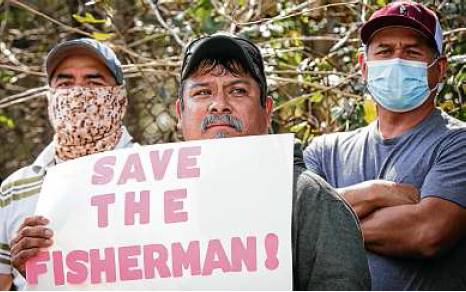Out-of-work oyster fishermen protest over Texas reef closures
By Emily Foxhall STAFF WRITER
DICKINSON — Alejandro Gutierrez should have been out on his boat harvesting oysters Wednesday, as he has done pretty much every weekday for the last 35 years. Instead, he was marching alongside more than 100 other fishermen and their supporters in the circle driveway of a Texas Parks and Wildlife Department coastal fisheries building.
Gutierrez hasn’t been able to collect many oysters this year because the department closed so many reefs. He and others were here protesting because they hoped to change that. This is the middle of oyster season. Usually, it’s a stable income, he said. But Gutierrez is now struggling to pay bills.
“Since December, we haven’t worked a whole lot,” said Gutierrez, a 53-year-old father of four who lives in Galveston. “This is my life. This is what I know how to do.”
Buddy Guindon, a fisherman and founder of the popular Katie’s Seafood Market, near where Gutierrez keeps his boat, listened in. Guindon relied on oyster suppliers at his restaurant. “All these guys want to do is hard work,” Guindon added.
TPWD has closed 21 of 27 oyster harvest areas across the state’s bays, and another is closed due to concerns about water quality. The agency says it has to halt fishing temporarily because there aren’t enough oysters that are big enough. The agency wants to give them time to grow so the reefs aren’t damaged.
That the agency has had to close so many isn’t normal — but it isn’t unprecedented either. The same number of reefs also were closed four years ago, according to TPWD. Heavy rainfall can be part of the problem because it changes the salinity of the water where the oysters live.
TPWD said its aim in oyster management is to balance the region’s ecological needs with the community’s economic concerns.
“Our goal is to find a balance between these roles by protecting ecosystems while allowing for sustainable fisheries and coastal communities to thrive,” an agency spokesperson said in a statement. “Our management strategies use the best available science to ensure Texas’ oyster populations remain healthy and viable into the future.”
Still, on Wednesday, the impact on the lives of the people who rely on being paid to harvest oysters was hard to ignore. It wasn’t just the fishermen and restaurant owners feeling the economic downturn. There were people who bought oysters, and people who transported them in trucks. They came from places such as Texas City and San Leon.
And, like Gutierrez, they were struggling with how to make do.
Hugo Osornio, 54, explained that he loved his job as a fisherman, and he didn’t really know how to do anything else. He lives 10 miles away near Galveston Bay and wanted to see the reefs open again so he could get back to work. The father of two put it simply: “I’ve got to support my family, you know?”
They were the “farmers of the bay,” said Johny Jurisich, who is a buyer and fisherman. They knew how to care for and work the reefs, he explained.
Around and around the group marched with handmade signs that told their story. “Open up the bays,” one said. “Help us save our jobs,” another said. “Save Texas fishermen,” read a third. They chanted loudly over the sounds of traffic.
“Pescadores Unidos,” they shouted.
Fishermen united.
“¡Queremos trabajar!” they yelled.
We want to work. emily.foxhall@chron.com

